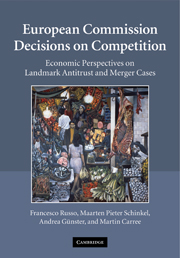 European Commission Decisions on Competition
European Commission Decisions on Competition Book contents
- Frontmatter
- Contents
- List of figures
- List of tables
- List of abbreviations
- Table of legislation
- Table of equivalences
- Acknowledgments
- 1 Introduction
- 2 Horizontal restrictions
- 3 Abuse of dominance
- 4 Licensing
- 5 Vertical restrictions
- 6 Joint ventures and alliances
- 7 Restrictions to competition by Member States
- 8 Mergers and acquisitions
- Annex I Decisions related to procedural issues
- Annex II Table of landmark decisions described in the book
- Annex III Table of mergers blocked by the European Commission in chronological order
- Annex IV Table of landmark merger decisions described in the book in alphabetical order
- Annex V Table of antitrust decisions in alphabetical order
- Bibliography
- Index
- References
8 - Mergers and acquisitions
Published online by Cambridge University Press: 04 August 2010
- Frontmatter
- Contents
- List of figures
- List of tables
- List of abbreviations
- Table of legislation
- Table of equivalences
- Acknowledgments
- 1 Introduction
- 2 Horizontal restrictions
- 3 Abuse of dominance
- 4 Licensing
- 5 Vertical restrictions
- 6 Joint ventures and alliances
- 7 Restrictions to competition by Member States
- 8 Mergers and acquisitions
- Annex I Decisions related to procedural issues
- Annex II Table of landmark decisions described in the book
- Annex III Table of mergers blocked by the European Commission in chronological order
- Annex IV Table of landmark merger decisions described in the book in alphabetical order
- Annex V Table of antitrust decisions in alphabetical order
- Bibliography
- Index
- References
Summary
Introduction
Mergers and acquisitions (M&As) can have important effects on competitive conditions. At the same time, they can generate significant efficiencies, and so are often a natural part of industry evolution. In economic theory, an important distinction is made between horizontal, vertical, and conglomerate mergers. In horizontal mergers, there is a distinction between two types of possible anticompetitive effects: unilateral effects and coordinated effects. In vertical mergers, there are concerns about upstream or downstream foreclosure of rivals as part of the strategic considerations to merge. In conglomerate mergers, there may be combinations of these concerns at play.
Empirical reviews of the ex post effects of mergers on profitability, sales, and market shares have found that the economic effects of mergers can vary considerably from case to case.
The FEU Treaty does not provide any specific rule expressly installing merger control in Europe. Consequently, until the adoption of the first Merger Regulation in 1989, the control of potential anticompetitive effects of mergers could be achieved only by application of Article 101 and Article 102. As a result, the merging parties did not have a strict obligation to notify their merger plans to the Commission. Only by means of a broad interpretation of the Treaty provisions could anticompetitive mergers be controlled. Article 102, in particular, was utilized as an instrument to challenge possible abuses of dominance after the strengthening of an already dominant position via acquisition of competitors in markets in which competition is not sufficiently protected by, for example, low barriers to entry and supply-side substitution.
- Type
- Chapter
- Information
- European Commission Decisions on CompetitionEconomic Perspectives on Landmark Antitrust and Merger Cases, pp. 312 - 384Publisher: Cambridge University PressPrint publication year: 2010
References
- 5
- Cited by


